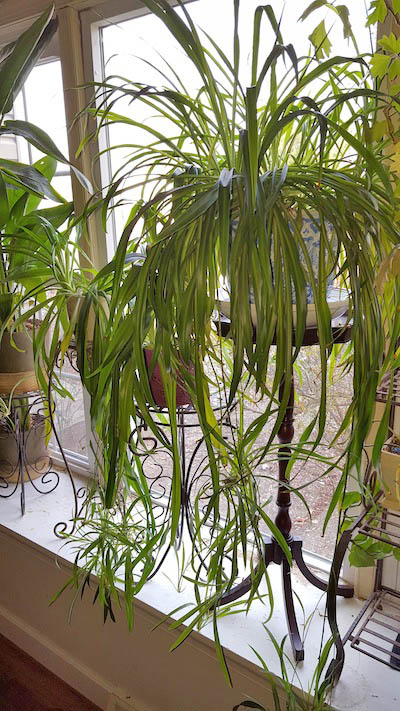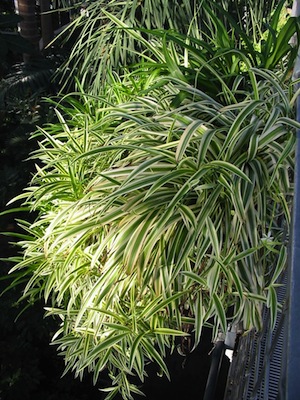The Spider You Will Welcome into Your Home
By Elaine Homstad, Fairfax Master Gardener
 When I was growing up, my mother always had houseplants around. They were just part of my life, as I helped water and care for them as part of my chores. So, when I moved out on my own, it was only natural that I would also have some. To me, that was one of the things that made a house a home, as the saying goes.
When I was growing up, my mother always had houseplants around. They were just part of my life, as I helped water and care for them as part of my chores. So, when I moved out on my own, it was only natural that I would also have some. To me, that was one of the things that made a house a home, as the saying goes.
As I searched the local variety store for a nice plant, I was intrigued by two plants that visibly reproduced themselves. One was the aptly named piggy-back plant, which produced small plantlets from the base of its heart-shaped leaves. The other was the spider plant, with its long, arching leaves and adorable little “babies” emerging along its long, curving stems. I bought them both, but the winner was definitely the spider plant, evidenced by my continuing friendship with it.
The adaptability of this plant makes it an ideal candidate even for those without even a tint of green in their thumbs!
Spider plants (Chlorophytum comosun) have fairly undemanding requirements. Because of their long leaves and even longer stems, they are well-suited to hanging baskets, or placement in an elevated position, so the baby plantlets can trail below. They, like most plants, prefer well-drained soil and regular watering. However, they do not enjoy wet feet, and benefit from being allowed to dry out a bit between waterings. They also prefer to be fed with 1/2 strength 4-4-4 liquid fertilizer, every third or fourth watering.
Hardy plants that are not overly fussy or susceptible to diseases, the one thing you may observe with spider plants are brown tips on the ends of their long leaves. These can be caused by too little or too much water, excessive fertilization, too much light, overly dry or heated air or chemicals found in tap water. If you can water your plants with distilled water or rainwater, that is ideal. However, since that is not usually an option for most people, I have found that allowing tap water to sit for several days in an open container before using it does just as well. Sometimes yellowing or browning leaves will occur at the outer crown. This is natural as the plant ages and produces new growth from the center, so just remove and discard them. You can also clip or pinch off any brown tips to improve the plant’s overall appearance.
As for insect pests, it is unlikely that your spider plants with be afflicted with any, but if they are, the most likely culprits will be the same ones that affect your other plants — aphids, spider mites, mealybugs, whiteflies and fungal gnats. Rinsing with water, cleaning the leaves with mild rubbing alcohol or spraying with an insecticidal soap are easy, non-toxic ways to treat these problems, should they occur.
Of course, one of the most popular benefits of owning a spider plant is its ability to reproduce itself. Once a plant has reached maturity, at about 2 years old, it will begin to send out smooth stems (called runners, scapes or stolons) among the leaves. A white star-shaped flower will form along the stolon, and those will eventually form a new plantlet. They can be left attached to the parent plant, for a beautiful display, or turned into new plants.
Propagating spider plants can be done in several ways. Should the plant become pot-bound, it can be divided as you would do with any houseplant. If the crown and roots of the plant are showing above the soil level, and water is just draining through, it is time to repot. The other way is to root the offspring to become new plants. Just clip off one or more of the “spiderettes,” and either plant them directly into potting soil, or place them into a container of water, only immersing the lower portion under the water. Change the water periodically and once a root system has formed, transplant it into soil.

variegated leaves
Like many houseplants, spider plants are tropicals. They are native to southern Africa and are naturalized outdoor perennials in some tropical climes. Although our region will not support them as year-round outdoor plants, you can transplant the spider babies to outdoor soil, treating them as annuals. Your potted spider plants will certainly appreciate summering outdoors, but be sure to inspect them thoroughly and give them a preventative cleaning and spraying with insecticidal soap prior to bringing them back into the house.
According to the ASPCA, spider plants are not toxic to dogs and cats, but I know from personal experience that some cats like to play with (and chew on) those pointed tips, and if they ingest enough of them, may vomit them back up.
Spider plants are available in a solid green variety, and in a green-and-white-striped variegated version.
Invite one of these spiders into your home, and you will truly want it to stay!
References
• Houseplants: Proper Care and Management of Pest Problems, Janet Knodel, Kasia Kinzer & Ron Smith,
North Dakota State University Extension Service
• Spider Plant, Toxic and Non-toxic Plants, ASPCA
• Spider Plant: Plant of the Week, Gerald Klingaman, University of Arkansas Cooperative Extension
updated 2021